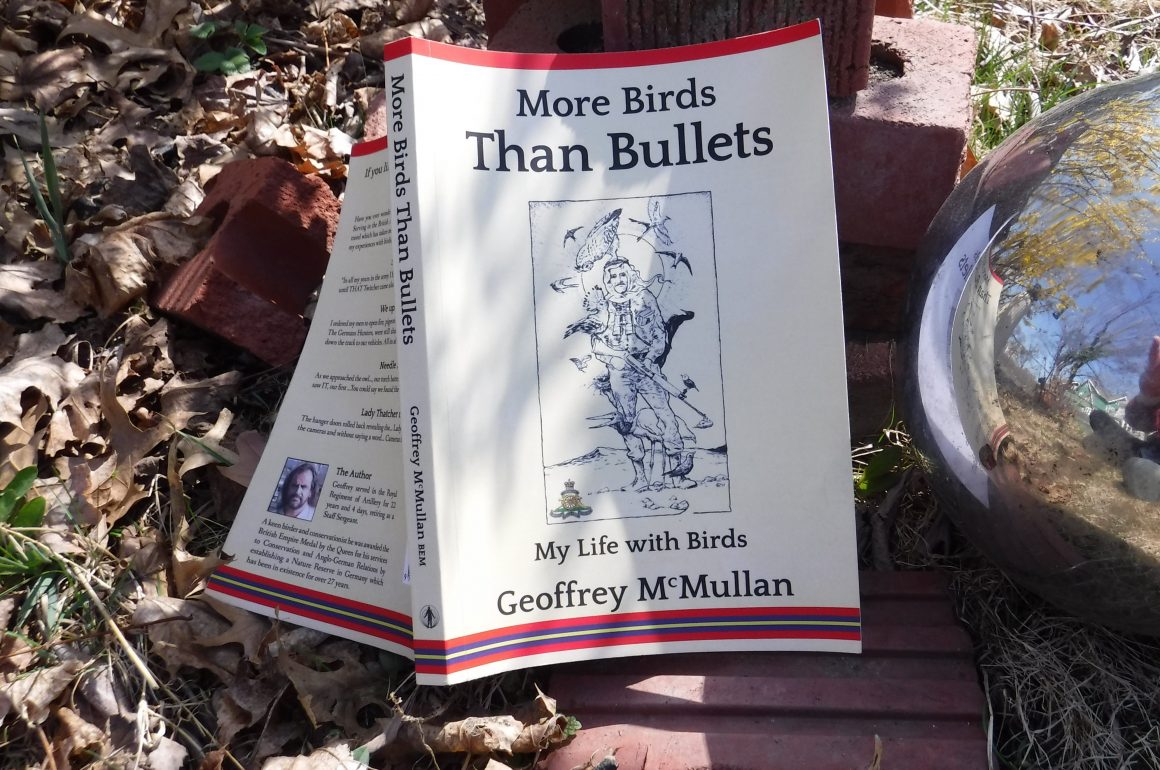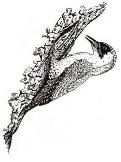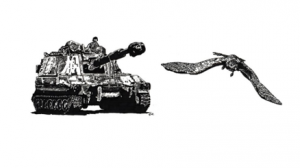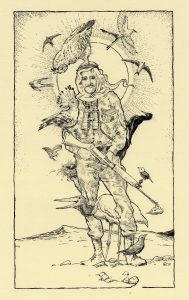
A cheeky lad, Geoffrey McMullan was regularly subjected to brutal discipline at his English boarding school. He found some solace when, at age eleven, he became entranced with birds – specifically, with a Green Woodpecker — and that sighting, he says, “took me to another, safer world.” 
The avian avocation became lifelong for McMullan, including for the 22 years he spent in the British Army (the Royal Regiment of Artillery), from which he retired as a Staff Sergeant, having become by that time an expert birder and artist, world traveler, naturalist, and seeming mystic of sorts. More Birds Than Bullets: My Life With Birds is his account of the centrality of birds in all of these endeavors, and in his life.
As McMullan tells it, birding goes pretty well with the military lifestyle, at least for himself and a select few others. “Hurry up and wait” applies to every army, and there is enough downtime to be able to sneak off for birding expeditions. Influence in high places helps, too, such as when, to his delight, McMullan, a mere corporal at the time, discovers that his Brigadier (the boss of McMullan’s boss) is avid to see a Tengmalm’s Owl that McMullan had photographed (in Germany), and gets McMullan to guide him.
And birds are, after all, everywhere, such as the Red-breasted Flycatcher that McMullan spots atop an ammo box in Kuwait (in the first Gulf War); or the stunningly beautiful song of the Greater Hoopoe Lark that wakes him, lying in his sleeping bag in the desert; or, less prosaically and more horrifically, various birds of prey flying off with human body parts in Iraq. What he calls “extreme birding” is part of his unique fun, as well – by that he means looking for lifers or other interesting birds while involved in such things as a firefight with the Taliban in Helmand Province in Afghanistan. As he says, “service personnel get to bird where no other birders can.” (Or would want to, one guesses.)

As shown by the photo, below, of McMullan and Merlin, his Eurasian Eagle Owl friend, McMullan is a rough-hewn 6’4” foot bear of a man; he describes himself as resembling a character from the World Wrestling Federation.

But bears can be sensitive creatures, as well, and some of the best parts of the book are when McMullan describes himself, alone in nature, in silent contemplation and observation, being attentive to the concentric rings of energy he radiates as he walks, or sits. (He’s somewhat of a devotee of the tracking and bushwork guru Tom Brown, Jr.)
McMullan had some sort of spiritual awakening in Bosnia when he saw a woman weeping outside her destroyed home. But he pretty much drops the subject, except for a final Chapter 9, “My Transition,” when he addresses it briefly, and says “I could write a book about these experiences alone.” He probably should do.
In his Preface, McMullan warns the reader that the book is not written in chronological order and he’s not kidding: the narrative goes from Thailand to Seattle, from Senegal to the Everglades, without segue or even much of a breath. He is not a stickler for standard orthography, syntax, or punctuation, and, despite his promise to limit the use of military jargon, the book is full of acronyms that are hard to keep track of.
But all that is OK: in a rollicking narrative like this one, the reader gets used to McMullan’s prose idiosyncrasies. It’s like being with a bunch of his squaddies down at the Gas Light bar on a Friday night, laughing and chaffing while downing pints, and listening to his stories.
More Birds Than Bullets is not the first of its genre. Jonathan Trouern-Trend’s Birding Babylon: A Soldier’s Journal From Irag, a lovely little 2006 book, is also well worth your time.

_______________________________________________________________________________________
Drawings of the Green Woodpecker and M109 American Artillery Self Propelled Gun (not a tank), with Common Buzzard by Geoffrey McMullan; photo of Geoffrey McMullan and Merlin (not a merlin) by Frank Edwards; drawing of Geoffrey McMullan by Cliff Wright.
_______________________________________________________________________________________
More Birds Than Bullets: My Life With Birds. By Geoffrey McMullan. Pathfinder UK, 2020, 220 pp., £14.99 UK, $18.99 US, €16.99 EU. ISBN 978-0-9576181-4-5 (Paper); ISBN 978-0-9576181-3-8













I read this book recently and I liked the stories of woodpeckers and owls, the main contribution of the book to my knowledge was the chapter „Bird Language“, especially the method of the sit spot. That kind of approach to birdwatching introduced to me a new philosophy, a totally new concept. Chapters focusing on „Extreme Birding“ or describing birding at distant destinations, as at the Falkland Islands, South Georgia, or Asian deserts, were notably capturing for me. The book recalled to me also a number of my personal stories connected with my birdwatching and nature-trips. I recommend this book to everybody who likes birding, travelling and exploring of distant edges of our planet.
Samuel – Košice, Slovakia
What a nice write up, Mark! And congratulations, Geoffrey – I enjoyed the heck out of your book. Great tales, travels, and lots of birds.
“More Birds Than Bullets” is indeed a fantastic read! Geoffrey McMullan does a wonderful job of sharing his experiences, taking it to a whole new level. I had no idea that military life and birdwatching could be mixed together; however, I have been proven wrong! The author’s ability to intertwine several themes from beginning to end makes it hard to put this book down – be it birds, travel, military experiences, or humor – this book has it all! Thank you 10,000 Birds for featuring this book on your blog – it’s well deserved! Let’s all keep spreading the word for this awesome book!
https://morebirdsthanbullets.yolasite.com/
Geoffrey McMullan has written an interesting and, I think, unique little book about his birding and other experiences while a member of the British Army, and afterwards, as a civilian. This is not your standard birder’s diary, nor is it a detailed ornithological treatise. The author jumps around, both in years and in geography, describing his adventures all over the globe, including the Falklands, Belize, Iraq, Afghanistan, and Thailand. Much of his descriptions of particular bird species focuses on his two favorite avian groups: woodpeckers and owls.
I found two aspects of the book to be somewhat unique, namely his descriptions and experiences with “bird language”: the art of interpreting the calls, posture, and other behavior of birds that convey more information than just the color, shape, and name of a bird; and secondly, his transition from merely observing and photographing birds to actively working on conservation measures to ensure their survival. Specifically, he was instrumental, along with local environmental groups, in the establishment of the 358-acre Zachariassee Nature Reserve in Germany. His efforts included drawing up a habitat plan, securing funding & local labor, as well as surveying the local bird life. For these efforts, McMullan was awarded the British Empire Medal by Queen Elizabeth! In addition to reading of his travels and the birds he saw, I also learned some really interesting and often funny British military jargon!
And, to top it all off, the book is lightly illustrated by the author, an accomplished bird artist. I highly recommend this unusual and interesting book to all birders, beginners or experts. You can also order the book directly from the author at: https://morebirdsthanbullets.yolasite.com .
Mark, I agree completely with your take on More Birds than Bullets. I ordered Geoffrey’s book after reading a review on Birdforum.net, and I’m glad I did. It’s a look at birdwatching unlike any other I’ve ever read. I’m hoping to entice the author to southern Arizona some day to show him around our best spots.
Great review, Mark!
This wildly entertaining book is a joy ride from beginning to end. Armed with an open mind, keen powers of observation, and a vivid writing style, Geoffrey McMullan expertly describes the adventure side of birding. More Birds than Bullets is a must read for anyone who enjoys the outdoors.
Weaving together his experiences from his long career with the Royal Artillery and his almost life-long fascination with birds, Geoffrey rewards his readers with a real sense of accompanying him along the way. The heartbeat of the book is found in the author’s advice to “never say never when it comes to birds, they have a habit of proving you wrong.” As an illustration, we find an authority on the Middle-spotted Woodpecker asserting that “Middle-spotteds never go to the ground,” only to be disproven the very next day on a field trip, when all the participants (including “the authority”) witnessed a Middle-spotted on the ground.
More Birds than Bullets is an instructional manual on the art of living. Geoffrey’s boundless curiosity about our world and the creatures who inhabit it is inspiring. Regarding birds, we learn interesting tidbits such as them using roads as sources of warmth at night. I particularly enjoyed the discussion about the art of interpreting bird language. I have already become a better birder by following Geoffrey’s tips. About people, we learn that the best way to connect with others is through respect and empathy, regardless of apparent cultural divides. About the military, we learn the utility of “tactical breakdowns” and the unique opportunities for “extreme birding.”
I whole-heartedly recommend More Birds than Bullets. In searching for a criticism, the only thing I could come up with is the lack of an index. In my own birding experiences, nuances of similar bird behavior keep popping up such that I say (for instance), “oh yeah, Geoffrey wrote about that…now where was that discussion of Whimbrels responding to people switching from ‘a heart space into our heads’?” Upon reflection, I am happy about the lack of an index. I now have an excuse to reread More Birds than Bullets with a commitment to taking better notes this time.